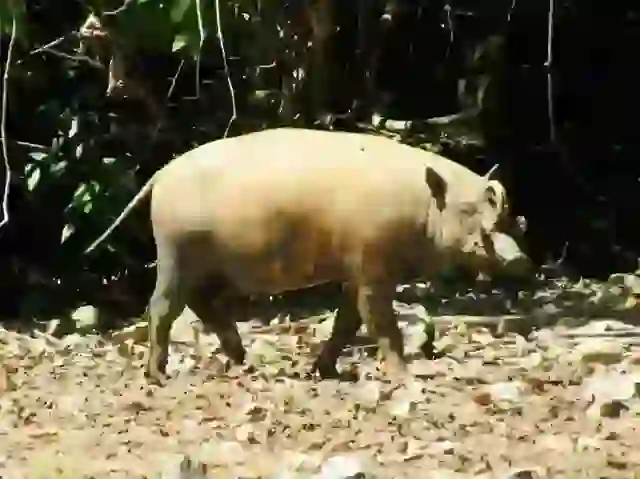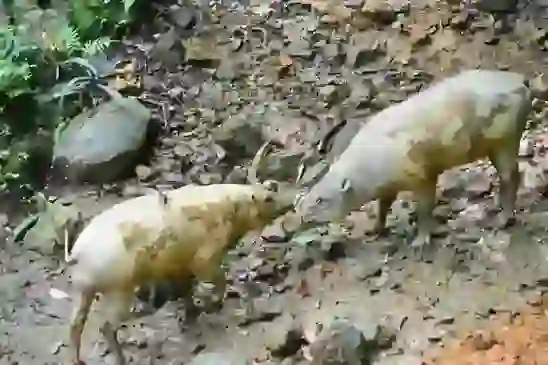
Babirusa
Babirusa
Babirusa
Do you know the mysterious animal called babilsa, whose big canine teeth protrude from the skin of the upper chin? Babilsa is said to be a species of wild boar that lives only in limited areas of Indonesia. However, even people who have never seen them, and who do not know their names, once they see them, they have an unforgettable impact. In this article, let's take a look at what features and secrets babilsa has!
Babirusa Basic Infomation

Mammalia-Cetartiodactyla-Suidae.
Length 90~110cm. Weight 60~100Kg.
Babirusa is a species of wild boar found in the rainforests of Sulawesi, Toguan, Sura and Bull islands in Indonesia.The biggest feature is the huge upper jaw canine teeth (tusk) that penetrate the skin of the face and curl backwards to grow, and its length is up to about 30cm.
Since the canine teeth of the lower chin also grow longer, the male face of babirusa is in an upward state with four huge canine teeth, making it a unique appearance that other animals do not see.By the way, this characteristic canine tooth only grows in males, and it is rarely seen in females.
Babirusa's body color is brownish-black, and in most cases the hair grows only sparsely.Compared to other boar friends, they have longer limbs and a slender body overall.It is also a daytime animal that is active during bright times and usually lives alone or in small family groups.
In the wild, babirusa reaches sexual maturity at 1-2 years of age, and in captivity, it reaches 5-10 months of age and is able to reproduce.The pregnancy lasts 150 to 164 days, and one or two children are born at a time.The size of the newborn baby is about 15-20cm.
Babirusa Q&A

Where did the name babirusa come from?
In fact, the name babirusa means “pig deer” in Indonesian.In Indonesian, “babi” means pig and “roesa” means deer.
Although babirusa itself has the appearance of a pig, it is thought that the tusks that grow from the upper jaw are similar to the antlers of deer, so it is named like this.

Why does babirusa live there?
Babirusa is found only in the tropical rainforests of Sulawesi, Toguan, Sura and Bull islands in Indonesia, as well as the surrounding wetlands and marshes.
I looked into why babirusa inhabited these limited islands, but unfortunately I did not get a clear answer.However, considering that there are few natural enemies in any habitat, and that there is enough water and mud to protect food and skin from dryness and parasites, it is thought that these islands were a livable environment for babirusa.
In the past, babirusa lived on a wide range of islands, but environmental destruction has progressed, and unfortunately, many individuals are now only seen in limited protected areas.

What is babirusa eating?
Babirusa is an omnivorous animal that eats a variety of things in the wild, including tree leaves, fruits, plant seeds, mushrooms, insects, and snails.
In fact, in the nose of boars and pigs, which are companions of the same boar as Babirusa, there is a bone called "rostral bone".Boars and pigs can dig hard ground thanks to this bone to look for food (such as plant roots and worms), but this bone is missing from babilsa's nose.
Therefore, babirusa does not dig the ground, and it is often seen using hooves to dig rotten trees and take out the larvae of insects inside and eat them.
In addition, it seems that the zoo provides grasses such as timothy and alfalfa, vegetables and fruits, and pellets for herbivores rich in dietary fiber.

Why are babirusa's canine teeth so big?
What are the biggest features of babirusa?If you ask, many people think of male canine teeth that are too big.Why are babirusa canine teeth so big?
Several theories have so far been advanced about the role of the canine tooth in babirusa, such as "It is useful in defending in the battle between males" or "I wonder if the canine tooth is so large and respectable that it is so popular with females."
But we still don't know exactly why babirusa's canine teeth grow so long.Many animals use their dog teeth for hunting and fighting.
However, it is thought that babirusa's canine teeth are somewhat fragile and lack durability when used for battle and hunting.
The canine teeth of the aging male Babirusa can exceed 30cm and eventually stick into the head.
This is why Babirusa is sometimes called “the animal that watches his own death”, but it is unclear whether there is actually a Babirusa whose canine tooth stuck in his head and died.

What is the difference between babirusa and a wild boar?
Babirusa is a species of wild boar, but it is considered to be one of the most primitive.What is the difference between babirusa and wild boar?
First of all, the difference in appearance is that there is almost no hair in babirusa, and there is solid hair in the wild boar.Wild babirusa is often observed to bathe in mud and water so that the skin does not dry out.
Also, as explained in "What is babirusa eating?", babirusa does not have the "rostral bone" that other boar companions have. Also, since the shape of the stomach is very different from that of wild boars and pigs, there was a time when it was suspected that it was a ruminant.

What kind of personality is babirusa?
Babirusa is said to be a cautious and cautious personality.
Babirusa is inhabited in the rainforest and has a discreet personality, making it very difficult to find it in the wild.Much of the wild life of babirusa is still shrouded in mystery.
However, mothers who have children are very nervous and become very aggressive in order to protect their children.

Can babirusa be kept as a pet?
When breeding rare animals at home, in some countries it is necessary to follow the law. This time, we will introduce whether it is possible to breed babirusa at home in Japan.
Babirusa is a threatened extinct animal classified in Annex I to the Washington Convention.Animals listed in Appendix I can only be traded for academic research purposes and cannot be traded for commercial purposes.
Therefore, it is considered that it is impossible to purchase (import) Babirusa itself in order to raise it as a pet by an individual.

Is there a place in Japan where I can see babirusa?
Unfortunately, there are no zoos that currently keep babirusa in Japan.
Overseas, there are several zoos that breed babirusa, and it seems that they are bred in the "San Diego Zoo", "Los Angeles Zoo", "Louisville Zoo" in the United States and "Singapore Zoo" in Singapore to the extent that it can be confirmed.

What is the lifespan of babirusa?
Babirusa is thought to have a lifespan of around 24 years in captivity and 7-12 years in the wild.
Considering that the life span of wild boars in Japan is 1-2 years, and as long as about 10 years, we can see that Babirusa has a very long life span.

What enemies does babirusa have?
Because there are no large carnivores in the habitat of babirusa, it is believed that there are few natural enemies in adult babirusa.Babirusa's babies may be preyed upon by pythons and civets, but the biggest enemy of babirusa is not carnivores.
Babirusa's greatest natural enemy is us humans.
First, wild babirusa is hunted and poached by locals for food.In addition, the continued development of the rainforest habitat, all four species of babirusa, have reduced their number of habitats.
It is also said that the reason why the number of babirusa is decreasing is related to their fertility.This is because the number of babies born to wild boars is usually 4-5 (depending on the species), and the number of pigs is about 10 (depending on the breed).However, because babirusa only gives birth to one or two children at a time, it is difficult to increase the number of individuals.
Babirusa was designated a protected animal by Indonesian law in 1931 and was listed as a Vulnerable Species (VU) on the International Union for Conservation of Nature (IUCN) Red List in 1978.

Would you like to become a part of the 'Animalbook.jp'?
Turn your knowledge into Q&A and share it with the world. ※Publication will be activated after purchase. Let's share information together!
Babirusa Type of List

・Babirusa
・Buru Babirusa
・North Sulawesi Babirusa
・Togian Babirusa
※Classifications may vary between researchers and papers.
Information
Congratulations! You are the first commenter!

Create Your Favorite List!
Babirusa
Save the animals you love! Build your own list to quickly revisit your favorites later.

Would you like to leave a comment?
※Please note: This is for the purchase of rights to post comments within the article.
Find Your Favorites!
Our shop offers a unique and attractive selection of goods themed around various animals.
Babirusa References

- Los Angeles Zoo「Babirusa」 https://www.lazoo.org/explore-your-zoo/our-animals/mammals/babirusa/
- Singapore Zoo「Babirusa」 https://www.mandai.com/en/singapore-zoo/animals-and-zones/babirusa.html
- Louisville Zoo「Babirusa」 https://louisvillezoo.org/animalsandplants/babirusa/
- San Diego Zoo「Babirusa」 https://zoo.sandiegozoo.org/animals/babirusa
- 哺乳類科学第58巻別冊(2018年6月)「世界哺乳類標準和名目録」 https://www.jstage.jst.go.jp/article/mammalianscience/58/Supplement/58_S1/_pdf
- 東京大学総合研究博物館「B27 バビルサ頭骨」 https://www.um.u-tokyo.ac.jp/UMUTopenlab/library/b_27.html
- Facebook「科学雑誌Newton(ニュートン)2019年1月1日」 https://www.facebook.com/NewtonScience/photos/2042946282460540/
- 経済産業省「ワシントン条約規制対象種の調べ方・動物(サンゴ類含む)」 https://www.meti.go.jp/policy/external_economy/trade_control/02_exandim/06_washington/download/cites_appendices_fauna.pdf
- EAZA「EAZA Best Practice Guidelines Babirusa (Babyrousa)」 https://www.eaza.net/assets/Uploads/EAZA-Documents-Other/2018-Babirusa-EAZA-Best-Practice-Guidelines-Approved.pdf
Babirusa Introduction of media used

出典:https://commons.wikimedia.org/wiki/File:Hirscheber1a.jpg

出典:https://commons.wikimedia.org/wiki/File:Babirusa_pair.jpg

出典:https://commons.wikimedia.org/wiki/File:Babirusa_Sulawesi.jpg

出典:https://commons.wikimedia.org/wiki/File:BabirusaGray.jpg

other
出典:https://commons.wikimedia.org/wiki/File:Babyrousa_babyrussa_05_MWNH_123a.jpg

出典:https://commons.wikimedia.org/wiki/File:Babirusa_Mainunggu.jpg

出典:https://pixabay.com/images/id-3036549/

出典:https://commons.wikimedia.org/wiki/File:Babiroussa.jpg

Help Enrich Our Animalbook.jp with Your Media!
We are constantly looking to expand and enrich our Animalbook.jp with amazing photos and videos of animals. If you have any media that you'd like to share, please contribute and help us showcase the beauty and diversity of the animal kingdom. Your submissions will be credited and featured in our encyclopedia, reaching a wide audience of animal lovers.






















